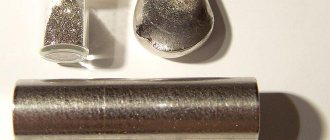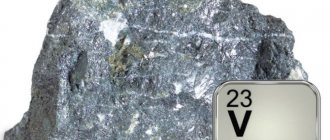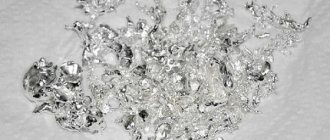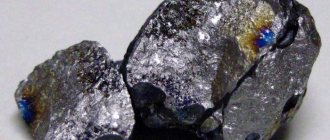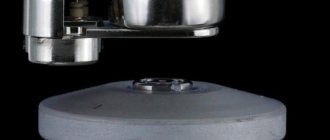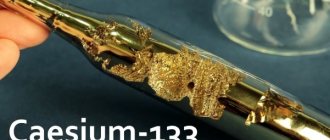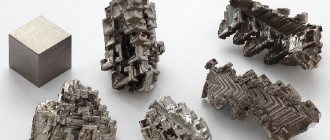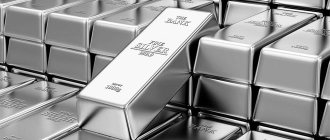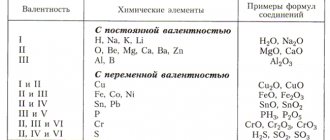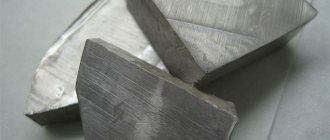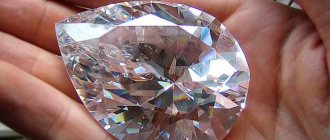The rapid development of modern technologies today is certainly associated with the use of effective materials and substances that have quite practical and very useful properties and features.
From this perspective, it is worth paying attention to such a unique chemical element as tantalum. And this is not surprising, because thanks to its strength characteristics, today the use of tantalum is becoming quite relevant in many areas of industry.
To broaden the horizons of the average person on this topic, we will describe in detail the physical and chemical properties of tantalum and talk about where this metal is very successfully used today.
Tantalum, properties of the atom, chemical and physical properties.
Ta 73 Tantalum
180.94788(2) 1s2 2s2 2p6 3s2 3p6 3d10 4s2 4p6 4d10 4f14 5s2 5p6 5d3 6s2
Tantalum is an element of the periodic system of chemical elements of D.I. Mendeleev with atomic number 73. It is located in the 5th group (according to the old classification - a secondary subgroup of the fifth group), the sixth period of the periodic system.
Tantalum atom and molecule. Tantalum formula. Structure of the tantalum atom
Isotopes and modifications of tantalum
Properties of tantalum (table): temperature, density, pressure, etc.
Physical properties of tantalum
Chemical properties of tantalum. Interaction of tantalum. Chemical reactions with tantalum
Obtaining tantalum
Applications of tantalum
Table of chemical elements D.I. Mendeleev
Receipt
The main raw materials for the production of tantalum and its alloys are tantalite and loparite concentrates containing about 8% Ta2O5
, 60% or more
Nb2O5
.
Concentrates are decomposed by acids or alkalis, while loparite concentrates are chlorinated. The separation of Ta
and
Nb
is carried out using extraction.
Metallic tantalum is usually obtained by reduction of Ta2O5
with carbon, or electrochemically from melts. Compact metal is produced by vacuum arc, plasma melting or powder metallurgy.
Tantalum atom and molecule. Tantalum formula. Structure of the tantalum atom:
Tantalum (lat. Tantalum, named after the hero of ancient Greek mythology Tantalus) is a chemical element of D. I. Mendeleev’s periodic system of chemical elements with the designation Ta and atomic number 73. Located in the 5th group (according to the old classification - a secondary subgroup of the fifth group) , the sixth period of the periodic table.
Tantalum is a metal. Belongs to transition metals.
Tantalum is designated by the symbol Ta.
As a simple substance , tantalum under normal conditions is a hard, heavy, silvery-white metal with a faint leaden (bluish) tint due to the formation of a dense oxide film.
The tantalum molecule is monatomic.
The chemical formula of tantalum is Ta.
The electronic configuration of the tantalum atom is 1s2 2s2 2p6 3s2 3p6 3d10 4s2 4p6 4d10 4f14 5s2 5p6 5d3 6s2. The ionization potential (first electron) of the tantalum atom is 728.42 kJ/mol (7.549571(25) eV).
Structure of the tantalum atom. The tantalum atom consists of a positively charged nucleus (+73), around which 73 electrons move through six shells. In this case, 71 electrons are in the internal level, and 2 electrons are in the external level. Since tantalum is located in the sixth period, there are only six shells. First, the inner shell is represented by the s-orbital. The second - the inner shell is represented by s- and p-orbitals. The third and fifth - inner shells are represented by s-, p- and d-orbitals. The fourth - the inner shell is represented by s-, p-, d- and f-orbitals. The sixth - outer shell is represented by the s-orbital. At the internal energy level of the tantalum atom, there are three unpaired electrons in the 5d orbital. At the outer energy level of the tantalum atom, there are two paired electrons in the 6s orbital. In turn, the nucleus of a tantalum atom consists of 73 protons and 108 neutrons. Tantalum belongs to the d-family elements.
The radius of the tantalum atom (calculated) is 200 pm.
The atomic mass tantalum atom is 180.94788(2) a. eat.
Tantalum, properties of the atom, chemical and physical properties
Application
Originally used to make wire for incandescent lamps. Today, tantalum and its alloys are used to make:
- heat-resistant and corrosion-resistant alloys;
- corrosion-resistant equipment for the chemical industry, dies, laboratory glassware and crucibles for the production, melting, and casting of rare earth elements, as well as yttrium and scandium;
- heat exchangers for nuclear energy systems (tantalum is the most stable of all metals in superheated melts and cesium-133 vapors);
- in surgery, sheets, foil and wire made of tantalum are used for fastening tissues, nerves, suturing, making prostheses that replace damaged parts of bones (due to biological compatibility);
- tantalum carbide (melting point 3880 °C) is used in the production of hard alloys (mixtures of tungsten and tantalum carbides - grades with the TT index, for the most difficult conditions of metalworking and rotary impact drilling of the strongest materials (stone, composites);
- in the production of ammunition, tantalum is used for the manufacture of metal lining of promising shaped charges that improves armor penetration;
- tantalum and niobium are used to produce electrolytic capacitors with high specific capacitance (but tantalum allows the production of higher quality capacitors);
- tantalum has been used in recent years as a jewelry metal due to its ability to form durable oxide films of any color on the surface;
- tantalum-182 is used in nuclear physics laboratories of the Ministry of Internal Affairs.
- The nuclear isomer tantalum-180m2, which accumulates in the structural materials of nuclear reactors, can, along with hafnium-178m2, serve as a source of gamma rays and energy in the development of weapons and special vehicles.
Tantalum beryllide is extremely hard and resistant to oxidation in air up to 1650 °C, and is used in aerospace engineering.
Tantalum pentoxide is used in nuclear technology to melt glass that absorbs gamma radiation. One of the most widely used compositions of such glass is: silicon dioxide - 2%, lead monoxide (light) - 82%, boron oxide - 14%, tantalum pentoxide - 2%.
Properties of tantalum (table): temperature, density, pressure, etc.:
Detailed information on the website ChemicalStudy.ru
| 100 | General information | |
| 101 | Name | Tantalum |
| 102 | Former name | |
| 103 | Latin name | Tantalum |
| 104 | English name | Tantalum |
| 105 | Symbol | Ta |
| 106 | Atomic number (number in table) | 73 |
| 107 | Type | Metal |
| 108 | Group | Transition metal |
| 109 | Open | Anders Gustav Ekeberg, Sweden, 1802 |
| 110 | Opening year | 1802 |
| 111 | Appearance, etc. | A hard, heavy metal of a silvery-white color with a faint leaden (bluish) tint. |
| 112 | Origin | Natural material |
| 113 | Modifications | |
| 114 | Allotropic modifications | 2 allotropic modifications: – α-tantalum with a cubic body-centered crystal lattice, – β-tantalum with a tetragonal crystal lattice |
| 115 | Temperature and other conditions for the transition of allotropic modifications into each other | |
| 116 | Bose-Einstein condensate | |
| 117 | 2D materials | |
| 118 | Content in the atmosphere and air (by mass) | 0 % |
| 119 | Content in the earth's crust (by mass) | 0,00017 % |
| 120 | Content in seas and oceans (by mass) | 2,0·10-10 % |
| 121 | Content in the Universe and space (by mass) | 8,0·10-9 % |
| 122 | Abundance in the Sun (by mass) | |
| 123 | Content in meteorites (by mass) | 2,0·10-6 % |
| 124 | Content in the human body (by weight) | |
| 200 | Properties of the atom | |
| 201 | Atomic mass (molar mass) | 180.94788(2) a. e.m. (g/mol) |
| 202 | Electronic configuration | 1s2 2s2 2p6 3s2 3p6 3d10 4s2 4p6 4d10 4f14 5s2 5p6 5d3 6s2 |
| 203 | Electronic shell | K2 L8 M18 N32 O11 P2 Q0 R0 |
| 204 | Atomic radius (calculated) | 200 pm |
| 205 | Empirical atomic radius* | 145 pm |
| 206 | Covalent radius* | 138 pm |
| 207 | Ion radius (crystalline) | Ta3+ 86 (6) pm, Ta4+ 82 (6) pm, Ta5+ 78 (6) pm (in parentheses the coordination number is indicated - a characteristic that determines the number of nearest particles (ions or atoms) in a molecule or crystal) |
| 208 | Van der Waals radius | |
| 209 | Electrons, Protons, Neutrons | 73 electrons, 73 protons, 108 neutrons |
| 210 | Family (block) | d-family element |
| 211 | Period in the periodic table | 6 |
| 212 | Group on the periodic table | 5th group (according to the old classification - a secondary subgroup of the 5th group) |
| 213 | Emission spectrum | |
| 300 | Chemical properties | |
| 301 | Oxidation states | -3, -1, +1, +2, +3, +4, +5 |
| 302 | Valence | I, II, III, IV, V |
| 303 | Electronegativity | 1.5 (Pauling scale) |
| 304 | Ionization energy (first electron) | 728.42 kJ/mol (7.549571(25) eV) |
| 305 | Electrode potential | Ta5+ + 5e– → Ta, Eo = -0.81 V |
| 306 | Electron affinity energy of an atom | 31(2) kJ/mol (0.178 0(7) eV) |
| 400 | Physical properties | |
| 401 | Density* | 16.69 g/cm3 (at 20 °C and other standard conditions , state of matter – solid), 15 g/cm3 (at melting point 3017 °C and other standard conditions , state of matter – liquid) |
| 402 | Melting temperature* | 3017 °C (3290 K, 5463 °F) |
| 403 | Boiling temperature* | 5458 °C (5731 K, 9856 °F) |
| 404 | Sublimation temperature | |
| 405 | Decomposition temperature | |
| 406 | Self-ignition temperature of a gas-air mixture | |
| 407 | Specific heat of fusion (enthalpy of fusion ΔHpl)* | 36.57 kJ/mol |
| 408 | Specific heat of evaporation (enthalpy of boiling ΔHboiling)* | 753 kJ/mol |
| 409 | Specific heat capacity at constant pressure | |
| 410 | Molar heat capacity* | 25.36 J/(K mol) |
| 411 | Molar volume | 10.86774 cm³/mol |
| 412 | Thermal conductivity | 57.5 W/(mK) (at standard conditions ), 57.5 W/(mK) (at 300 K) |
| 500 | Crystal cell | |
| 511 | Crystal grid #1 | α-tantalum |
| 512 | Lattice structure | Cubic body-centered |
| 513 | Lattice parameters | 3.3058 Å |
| 514 | c/a ratio | |
| 515 | Debye temperature | 225 K |
| 516 | Name of space symmetry group | Im_ 3m |
| 517 | Symmetry space group number | 229 |
| 521 | Crystal grid #2 | β-tantalum |
| 522 | Lattice structure | Tetragonal |
| 523 | Lattice parameters | a = 10.194 Å, c = 5.313 Å |
| 524 | c/a ratio | 1,918 |
| 525 | Debye temperature | |
| 526 | Name of space symmetry group | P42/mnm |
| 527 | Symmetry space group number | |
| 900 | additional information | |
| 901 | CAS number | 7440-25-7 |
Note:
205* The empirical radius of the tantalum atom according to [1] and [3] is 146 pm and 149 pm, respectively.
206* The covalent radius of tantalum according to [1] and [3] is 170±8 pm and 134 pm, respectively.
401* The density of tantalum according to [3] and [4] is 16.65 g/cm3 (at 0 °C and other standard conditions , the state of matter is a solid) and 16.6 g/cm3 (at 20 °C and other standard conditions , the state of matter is a solid) respectively.
402* The melting point of tantalum according to [4] is 3015 °C (3288.15 K, 5459 °F).
403* The boiling point of tantalum according to [4] is 5500 °C (5773.15 K, 9932 °F).
407* The specific heat of fusion (melting enthalpy ΔHmelt) of tantalum according to [3] and [4] is 24.7 kJ/mol and 34.7 kJ/mol, respectively.
408* The specific heat of evaporation (enthalpy of boiling ΔHboiling) of tantalum according to [3] and [4] is 758 kJ/mol and 744.8 kJ/mol, respectively.
410* The molar heat capacity of tantalum according to [3] is 25.39 J/(K mol).
How much does molybdenum cost now?
The price of molybdenum scrap significantly exceeds the cost of other metal waste - metropolitan prices for this type of metal vary from 400 to 800 rubles per kilogram.
Interesting materials:
How to properly salt beef when cooking? How to salt pasta correctly? How to properly salt fish for cold smoking? How to write a synopsis for an article? How to make a business card for a competition? How to properly prepare a report on industrial practice? What is the correct form of secondary specialized or secondary specialized education? How to properly cut basil for drying? How to install the antenna correctly? How to properly place cups on your back when coughing?
Nanotech chargers
Nanogenerator technology can charge even clothes.
The technology, nicknamed by scientists as a “nanogenerator,” may completely eliminate the need for humanity to use chargers for their gadgets. Nanotechnological chargers, as planned by the developers, will have to draw kinetic energy not from an outlet, but from environmental resources.
The basis of the technology is the use of a piezoelectric material that is capable of generating electricity and is in a state of mechanical tension. In addition, the material has nanoscopic pores, which give it the shape of a flexible sponge. This means that such charging can be built in almost anywhere, for example, in a clothing pocket.
Submarine air purifier
Submariners vitally need clean air.
The issue of clean air on submarines is very acute and even vital. Therefore, the use of nanotechnology to solve this problem can be considered completely justified. So, some time ago, an air purification technology called SAMMS (an abbreviation for Self-Assembled Monolayers on Mesoporous Supports) was developed.
It involves the use of special nanoparticles located inside ceramic granules: such a material has a porous structure, which means it can absorb excess carbon dioxide. Moreover, the volume of these granules required for one submarine is minimal: according to information, one tablespoon of this material contains enough resources to purify the air on an entire football field.
Price per gram
Tantalum is not traded on any commodity exchange. In fact, it is not bought or sold in its pure form, but only in the form of tantalite ores, from which the metal can then be extracted. The price is determined through direct negotiations between the seller and the buyer; according to many estimates, the starting point of price list transactions in Moscow is 150-170 dollars. per kg.
In 2010, it was reported that Brazil and other South American countries produce about 40% of the world's annual supply, Australia comes in second with 21%, and Central Africa accounts for less than 10%.
Scientists believe that there is no more than 50 years left in Ta reserves based on the achieved level of modern consumption, and they demand the implementation of a global Ta utilization program.
The price of tantalite depends very much on demand. The price of tantalite ore has increased from about 75 dollars. per kg in 2010 to more than $270. per kg in 2011 and 2012, but since then the price has decreased and the negotiated price is used more in the market.
Nanofilter for water
An oil spill in the ocean will soon cease to be a disaster.
An oil spill in the ocean always turns into an environmental disaster, so a solution to the problem of water pollution has been sought for decades. But perhaps the answer has already been found, and nanotechnology is the key to it. Thus, Ohio State researchers are developing a unique film just a few nanometers thick.
They plan to use this film like this: in combination with a thin stainless steel mesh, oil is repelled, and water becomes purified. A similar technology was borrowed from...water lilies, which repel water in the same way - it is this process that researchers are trying to repeat.
Confusion with metals
The history of metal turned out to be very confusing. For a long time it was mistaken for niobium, and it took more than 30 years to prove otherwise. Until the beginning of the 19th century, both metals were not known to science. In 1801, Columbia was found in South America. A year later, in Sweden and Finland, Anders Ekeberg discovered a mineral with particles of an unknown metal, which he named tantalum in honor of the mythical character.
In 1809, William Wollaston compared two substances new to chemistry. Their properties were very similar, which is why the scientist concluded that they were all the same metal. His conclusions were confirmed by Friedrich Wöhler, and since then columbium and tantalum have been equated.
In the mid-40s of the 19th century, Heinrich Rose doubted the claims of his predecessors. He established that tantalum and columbium are separate elements. To emphasize the similarity of the metals, he renamed columbium niobium in honor of the legendary daughter of Tantalus. Later, Rose's conclusions were repeatedly confirmed, and he himself is often credited with the discovery of niobium.
